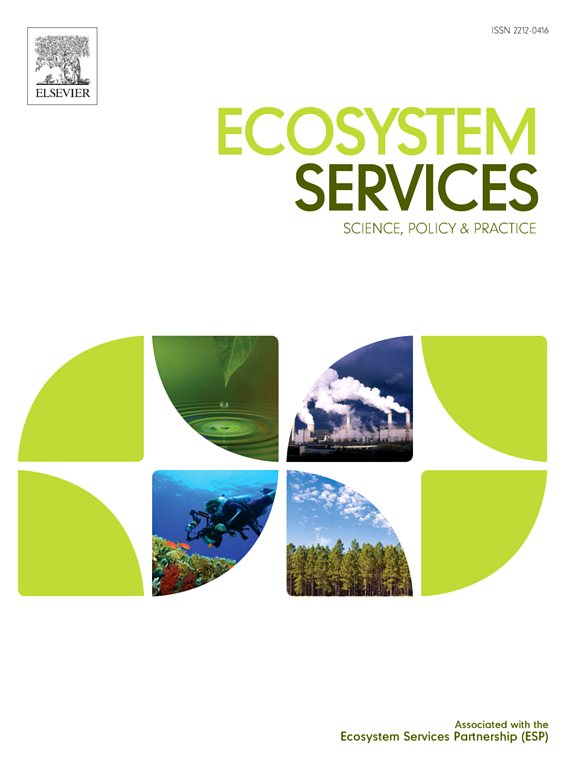城市绿地中多种文化生态系统服务的空间格局及相互作用
IF 6.6
2区 环境科学与生态学
Q1 ECOLOGY
引用次数: 0
摘要
城市绿地(UGS)通过提供有价值的生态系统服务,为人类福祉带来了巨大的好处。先前对UGS的研究主要集中在提供和调节服务,相对较少的研究明确地解决文化生态系统服务(CES),可能是由于其表征和量化的概念和方法上的挑战。社交媒体数据已经成为一种新的数据集,可以为这些无形的、高度具体的、但至关重要的消费电子产品的量化提供新的见解。在这项研究中,我们合并了多个平台,包括TripAdvisor和谷歌Maps,它们是最全面的用户生成数据集,来绘制和量化11个CES的空间分布。利用命名实体识别模型,本研究从抓取的评论中提取了60,156个与CES相关的文本实体,使我们能够将30,599条评论分类为426个城市绿地中不同的CES类型。我们的研究表明,CES的存在和多样性存在显著的空间异质性,并确定了六个关键的CES束,揭示了在UGS中,CES协同效应比权衡效应发生得更多。应用地理随机森林模型确定自然景观要素、生物多样性指标和人类效用指标在解释生态系统空间异质性中的相对重要性。研究发现,绿地面积、树木覆盖率、生物多样性和水景等因素是影响生态系统供应的重要因素。我们的研究为理解和量化城市环境中的消费环境提供了路线图和研究框架,并对UGS的可持续规划和管理具有启示意义,从而通过不同消费环境的贡献来改善社会福祉。本文章由计算机程序翻译,如有差异,请以英文原文为准。
Spatial patterns and interactions among multiple cultural ecosystem services across urban greenspaces
Urban greenspaces (UGS) deliver substantial benefits to human wellbeing by providing valuable ecosystem services. Prior research on UGS has been primarily focused on provisioning and regulating services, with comparatively fewer studies explicitly addressing cultural ecosystem services (CES), presumably due to conceptual and methodological challenges in their characterization and quantification. Social media data have emerged as novel datasets that could provide new insights into the quantification of these intangible, highly context-specific, but critically important CES. In this study, we merged multiple platforms, including TripAdvisor and Google Maps that are among the most comprehensive user-generated datasets, to map and quantify the spatial distribution of 11 CES. Employing named-entity recognition models, this study extracted 60,156 textual entities related to CES from scraped reviews, allowing us to categorize 30,599 reviews into different CES types across 426 urban greenspaces. Our research demonstrated substantial spatial heterogeneity in the presence and diversity of CES and identified six key CES bundles, revealing more occurrences of CES synergies than tradeoffs across UGS. Geographical random forest models were applied to determine the relative importance of natural landscape elements, biodiversity proxies, and human utility metrics in explaining the spatial heterogeneity of CES. We found that factors such as greenspace size, tree cover percentage, biodiversity, and water features emerged as strong predictors of CES provision. Our study provides a roadmap and research framework for understanding and quantifying CES in urban settings and has implications for the sustainable planning and management of UGS to improve social wellbeing through the contribution of diverse CES.
求助全文
通过发布文献求助,成功后即可免费获取论文全文。
去求助
来源期刊

Ecosystem Services
ECOLOGYENVIRONMENTAL SCIENCES&-ENVIRONMENTAL SCIENCES
CiteScore
14.90
自引率
7.90%
发文量
109
期刊介绍:
Ecosystem Services is an international, interdisciplinary journal that is associated with the Ecosystem Services Partnership (ESP). The journal is dedicated to exploring the science, policy, and practice related to ecosystem services, which are the various ways in which ecosystems contribute to human well-being, both directly and indirectly.
Ecosystem Services contributes to the broader goal of ensuring that the benefits of ecosystems are recognized, valued, and sustainably managed for the well-being of current and future generations. The journal serves as a platform for scholars, practitioners, policymakers, and other stakeholders to share their findings and insights, fostering collaboration and innovation in the field of ecosystem services.
 求助内容:
求助内容: 应助结果提醒方式:
应助结果提醒方式:


